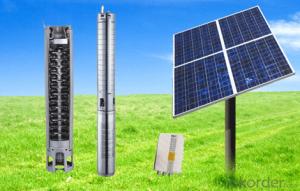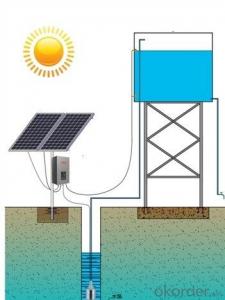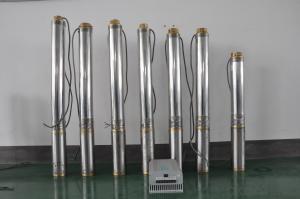Solar Pump Price Homemade Solar Water Heater
- Loading Port:
- Shanghai
- Payment Terms:
- TT OR LC
- Min Order Qty:
- 1 set
- Supply Capability:
- 1000 set/month
OKorder Service Pledge
OKorder Financial Service
You Might Also Like
Solar Pump Price Homemade Solar Water Heater
DC solar water pumping system consists of the motor, pump, controller, solar array and some other accessories, such as water level sensor, float switch, etc. Considered that storing water is more efficient than storing electricity, the system is designed to directly drive the pump without battery which can reduce the construction and operating cost and routine maintenance effectively.The PV array consists of multiple solar panels connected in series/parallel, which can supply the whole system as power source by converting the absorbed solar radiation energy to the electrical energy. The pump driven by a brushless DC permanent magnet motor draws water from deep-well or river. The pumped water is then fed into reservoir or water tank, or connected to the irrigation system or fountain system directly.
Advanced Technology
Applications Innovation
The efficiency of DC brushless permanent magnet motor has been increased up to 25% in comparison with traditional asynchronous motor.
Technology Innovation
Stator and rotor are sealed by environment friendly casting resin.Motor insulation resistance can be hold higher than 300MΩfor more than 10 years, which consumedly increased the security and reliability of the submersible motor.
Structure Innovation
Casting resign technology processed stator and rotor as well as the water lubricated bearing make the submersible pump environment friendly.
Feature
High Efficiency & High Reliability
DC Brushless Permanent Magnet Motor
Minimum Maintenance, long Service Life
Environment Friendly Materials, Lubricated Without Oil
Application
Village or Family Water Supply
Animal Drinking Water & Livestock Watering
Garden/Courtyard Irrigation
Swimming Pool
Water Supply for Bivouac or Camping Car
Water Supply for Remote Area
Automatic Control
Operate Automatically, No Need Watching
Maximum Power Point Tracking (MPPT)
Dry-run Protection

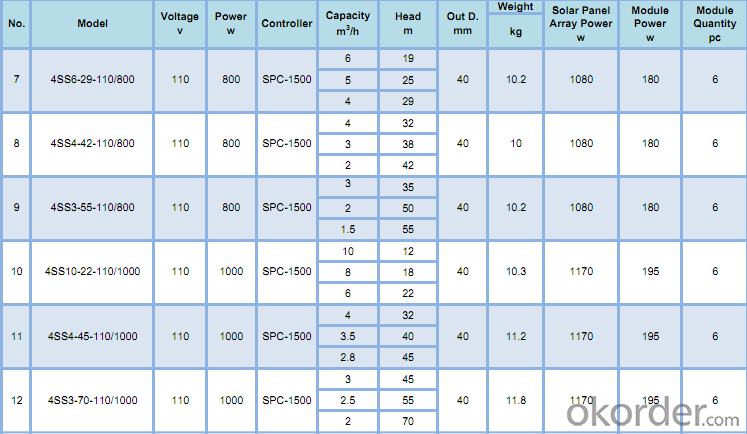
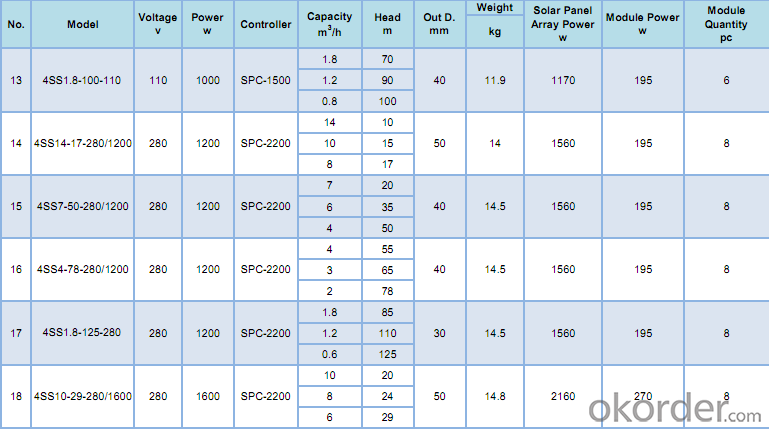
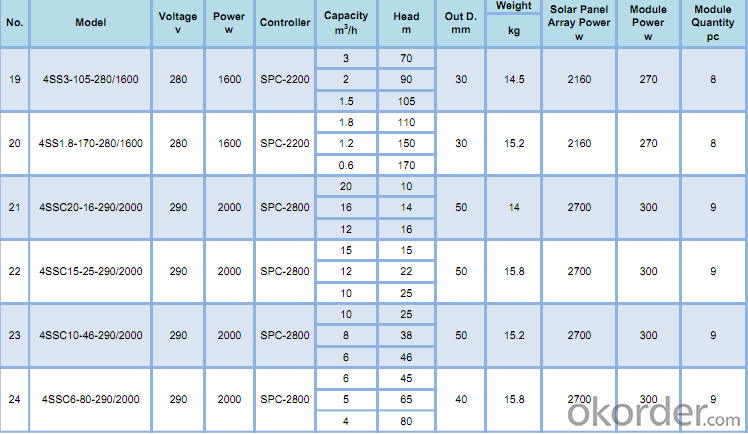

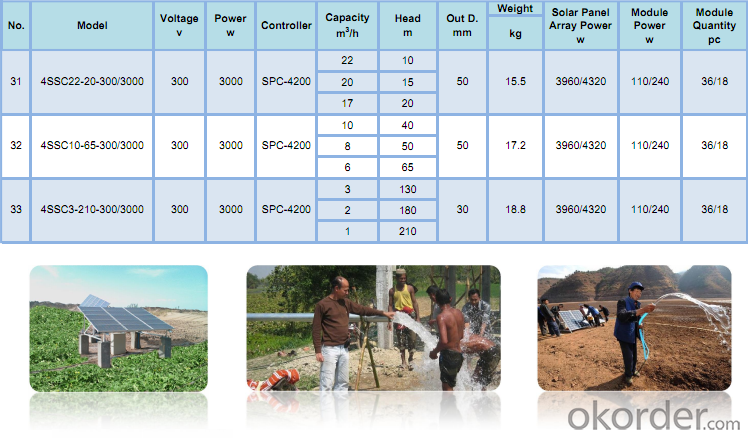
- Q:Can a solar pump be used for drinking water?
- Yes, a solar pump can be used for drinking water. Solar-powered pumps can efficiently extract water from wells, rivers, or other sources and provide a reliable and sustainable water supply for drinking purposes. These pumps are specifically designed to ensure the water remains safe and clean, making them suitable for drinking water applications in remote areas or regions with limited access to electricity.
- Q:Can a solar pump be used in areas with high levels of pollution?
- Yes, a solar pump can be used in areas with high levels of pollution. Solar pumps are powered by sunlight, so they do not rely on conventional power sources that contribute to pollution. As long as there is sufficient sunlight to generate electricity, the solar pump can operate efficiently regardless of the pollution levels in the area.
- Q:Can a solar pump be used for aquaculture or fish farming?
- Yes, a solar pump can be used for aquaculture or fish farming. Solar pumps are an excellent option for providing water circulation and aeration in fish ponds or tanks. They are environmentally friendly, cost-effective, and require minimal maintenance. Solar pumps use energy from the sun to power water pumps, which can be used to create water movement, oxygenate the water, and maintain proper water quality for the fish. This is essential for the health and growth of the fish in aquaculture or fish farming operations. Solar pumps can be designed to handle various water flow rates and depths, making them suitable for different sizes of fish ponds or tanks. They are also flexible in terms of installation, as they do not require complicated wiring or connection to the electricity grid. Using a solar pump for aquaculture or fish farming offers several advantages. Firstly, it reduces reliance on fossil fuels and decreases greenhouse gas emissions, contributing to a more sustainable and eco-friendly operation. Additionally, solar pumps can operate during power outages or in remote areas where access to electricity is limited, ensuring continuous water circulation and aeration for the fish. Furthermore, solar pumps are cost-effective in the long run. Although the initial investment may be higher compared to traditional electric pumps, solar pumps have lower operating costs as they utilize free solar energy. Over time, the savings on electricity bills can outweigh the initial investment, resulting in significant cost savings. In conclusion, a solar pump is a viable and efficient option for aquaculture or fish farming. It provides the necessary water circulation and aeration for the fish, reduces environmental impact, and offers long-term cost savings.
- Q:What is the maximum temperature a solar pump can handle?
- The maximum temperature a solar pump can handle can vary depending on the specific model and manufacturer. However, in general, most solar pumps are designed to handle temperatures up to 50-60 degrees Celsius (122-140 degrees Fahrenheit). It is important to refer to the product specifications provided by the manufacturer to determine the exact maximum temperature rating for a particular solar pump model. Additionally, it is advisable to install the pump in a location that minimizes exposure to extreme temperatures and provides adequate ventilation to ensure optimal performance and longevity.
- Q:How does a solar pump handle water with high levels of calcium or magnesium?
- A solar pump can handle water with high levels of calcium or magnesium by utilizing a filtration or purification system. These systems are designed to remove impurities, including minerals like calcium and magnesium, from the water before it reaches the pump. This helps prevent the build-up of mineral deposits in the pump and ensures efficient operation. Regular maintenance and cleaning of the filtration system are also essential to maintain its effectiveness in handling water with high mineral content.
- Q:Can a solar pump be used for rainwater harvesting or collection?
- Yes, a solar pump can definitely be used for rainwater harvesting or collection. Solar pumps utilize energy from the sun to power the pump and transfer water from a source to a storage tank. This makes them an ideal and sustainable option for collecting rainwater, as they eliminate the need for grid electricity. By using a solar pump, rainwater can be efficiently collected and stored for various purposes such as irrigation, household use, or replenishing groundwater.
- Q:How does a solar pump handle variable water levels?
- A solar pump is designed to handle variable water levels by utilizing sensors and control systems. When the water level drops below a certain point, the pump automatically adjusts its operation to extract water from deeper levels. Similarly, if the water level rises, the pump can adjust the intake to prevent overflows. This flexibility allows the solar pump to efficiently and effectively adapt to changing water levels while maintaining a steady flow.
- Q:What is the maintenance cost of a solar pump?
- The maintenance cost of a solar pump varies depending on several factors such as the type and size of the pump, the quality of components used, and the operating conditions. However, in general, solar pumps are known for their low maintenance requirements compared to traditional fuel-powered pumps. Some common maintenance tasks for a solar pump may include regular cleaning of the solar panels to ensure maximum sunlight absorption, inspecting and tightening electrical connections, checking and replacing worn-out parts such as bearings or seals, and monitoring the battery bank if the system includes energy storage. The frequency and cost of these maintenance activities can vary. On average, the annual maintenance cost for a solar pump can range from 1% to 3% of the initial investment cost. However, it's important to note that this is a rough estimate and can vary based on the specific circumstances. Furthermore, it's worth mentioning that the durability and reliability of the components used in the solar pump play a significant role in determining the maintenance needs and costs. Investing in high-quality equipment and reputable brands can help reduce the frequency and cost of maintenance. Overall, while there are maintenance costs associated with solar pumps, they tend to be lower compared to conventional pumps since solar pumps have fewer mechanical parts, require less frequent maintenance visits, and do not rely on expensive fuels.
- Q:Can a solar pump be used for water supply in zoos and wildlife sanctuaries?
- Yes, a solar pump can be used for water supply in zoos and wildlife sanctuaries. Solar pumps are a sustainable and eco-friendly option that can efficiently extract and distribute water, ensuring a reliable water supply for the animals in these habitats. Additionally, solar pumps can reduce operating costs and dependence on traditional energy sources, making them a practical choice for water supply in such environments.
- Q:Can a solar pump be used for fountains or decorative water features?
- Yes, a solar pump can indeed be used for fountains or decorative water features. Solar pumps are designed to operate using energy from the sun, making them a sustainable and eco-friendly option for powering water features. They can provide a constant flow of water, creating beautiful and tranquil displays without the need for electricity or batteries. Additionally, solar pumps are generally easy to install and maintain, making them a popular choice for enhancing the aesthetics of outdoor spaces.
1. Manufacturer Overview |
|
|---|---|
| Location | |
| Year Established | |
| Annual Output Value | |
| Main Markets | |
| Company Certifications | |
2. Manufacturer Certificates |
|
|---|---|
| a) Certification Name | |
| Range | |
| Reference | |
| Validity Period | |
3. Manufacturer Capability |
|
|---|---|
| a)Trade Capacity | |
| Nearest Port | |
| Export Percentage | |
| No.of Employees in Trade Department | |
| Language Spoken: | |
| b)Factory Information | |
| Factory Size: | |
| No. of Production Lines | |
| Contract Manufacturing | |
| Product Price Range | |
Send your message to us
Solar Pump Price Homemade Solar Water Heater
- Loading Port:
- Shanghai
- Payment Terms:
- TT OR LC
- Min Order Qty:
- 1 set
- Supply Capability:
- 1000 set/month
OKorder Service Pledge
OKorder Financial Service
Similar products
New products
Hot products
Hot Searches
Related keywords
